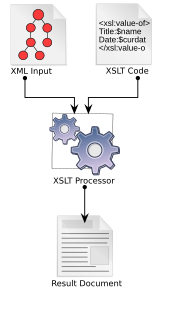In computing, the term Extensible Stylesheet Language (XSL) is used to refer to a family of languages used to transform and render XML documents.
XSLT is a language for transforming XML documents into other XML documents, or other formats such as HTML for web pages, plain text or XSL Formatting Objects, which may subsequently be converted to other formats, such as PDF, PostScript and PNG. XSLT 1.0 is widely supported in modern web browsers.
In computing, the Java API for XML Processing, or JAXP, one of the Java XML Application programming interfaces, provides the capability of validating and parsing XML documents. It has three basic parsing interfaces:
DocBook is a semantic markup language for technical documentation. It was originally intended for writing technical documents related to computer hardware and software, but it can be used for any other sort of documentation.
In software, an XML pipeline is formed when XML processes, especially XML transformations and XML validations, are connected.
XSL-FO is a markup language for XML document formatting that is most often used to generate PDF files. XSL-FO is part of XSL, a set of W3C technologies designed for the transformation and formatting of XML data. The other parts of XSL are XSLT and XPath. Version 1.1 of XSL-FO was published in 2006.
An XML editor is a markup language editor with added functionality to facilitate the editing of XML. This can be done using a plain text editor, with all the code visible, but XML editors have added facilities like tag completion and menus and buttons for tasks that are common in XML editing, based on data supplied with document type definition (DTD) or the XML tree.
XPath 2.0 is a version of the XPath language defined by the World Wide Web Consortium, W3C. It became a recommendation on 23 January 2007. As a W3C Recommendation it was superseded by XPath 3.0 on 10 April 2014.
The following tables compare XML compatibility and support for a number of browser engines.
The identity transform is a data transformation that copies the source data into the destination data without change.
In computing, the two primary stylesheet languages are Cascading Style Sheets (CSS) and the Extensible Stylesheet Language (XSL). While they are both called stylesheet languages, they have very different purposes and ways of going about their tasks.

The Oxygen XML Editor is a multi-platform XML editor, XSLT/XQuery debugger and profiler with Unicode support. It is a Java application, so it can run in Windows, Mac OS X, and Linux. It also has a version that can run as an Eclipse plugin.
The DocBook XSL stylesheets are a set of XSLT stylesheets for the XML-based DocBook language.

Muenchian grouping is an algorithm for grouping of data used in XSL Transformations v1 that identifies keys in the results and then queries all nodes with that key. This improves the traditional alternative for grouping, whereby each node is checked against previous nodes to determine if the key is unique . In both cases the key can take the form of an attribute, element, or computed value.
XMLStarlet is a set of command line utilities (toolkit) to query, transform, validate, and edit XML documents and files using a simple set of shell commands in a way similar to how it is done with UNIX grep, sed, awk, diff, patch, join, etc commands.
XPath is a query language for selecting nodes from an XML document. In addition, XPath may be used to compute values from the content of an XML document. XPath was defined by the World Wide Web Consortium (W3C).
XQuery is a query and functional programming language that queries and transforms collections of structured and unstructured data, usually in the form of XML, text and with vendor-specific extensions for other data formats. The language is developed by the XML Query working group of the W3C. The work is closely coordinated with the development of XSLT by the XSL Working Group; the two groups share responsibility for XPath, which is a subset of XQuery.
A Processing Instruction (PI) is an SGML and XML node type, which may occur anywhere in the document, intended to carry instructions to the application.

An XML transformation language is a programming language designed specifically to transform an input XML document into an output document which satisfies some specific goal.
IEEE STANDARD 1855-2016, IEEE Standard for Fuzzy Markup language (FML), is a technical standard developed by the IEEE Standards Association. FML allows modelling a fuzzy logic system in a human-readable and hardware independent way. FML is based on eXtensible Markup Language (XML). The designers of fuzzy systems with FML have a unified and high-level methodology for describing interoperable fuzzy systems. IEEE STANDARD 1855-2016 uses the W3C XML Schema definition language to define the syntax and semantics of the FML programs.


